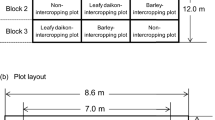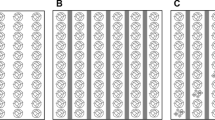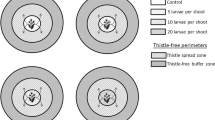Abstract
The population density of the diamondback moth (DBM), Plutella xylostella (L.), the species diversity of its predators, parasitism on eggs, larvae and pupae, and associated yield of canola were evaluated in experimental plots where spring canola was grown either as a monoculture or strip-intercropped with annual alfalfa in the ratio of 3C:3A, 6C:3A and 9C:3A over a 2-year period. The egg density was signifcantly higher in monoculture than in intercrops. The highest and lowest densities of larvae and pupae of DBM were recorded in monoculture (2.9–3.2 larvae per plant and 1.14–1.20 pupae per plant) and intercrop 3C:3A (0.7–0.6 larvae per plant and 0.34–0.29 pupae per plant), respectively. Shannon diversity index (H’) for species composition of the predators of DBM immature stages was lower in monoculture than in intercrops, and was similar amongst the three intercrops. Moreover, the percent parasitism for eggs, larvae and pupae was higher in intercrops than in monoculture. The dry seed weight loss was higher in monocrop (37.6–40.1%) compared to 3C:3A (7.9–8.6%), 6C:3A (19.5–21.4%) and 9C:3A (21.6–25.4%). Our results indicate that intercropping canola with annual alfalfa, especially in the ratio 3C:3A, can increase the species diversity, parasitism rates of DBM immature stages, and enhance the yield of canola. The implications of these fndings, in relation to integrated pest management (IPM) in canola cropping systems, are discussed.
Similar content being viewed by others
References
Altieri M. A., Nicholls C. I. and Ponti L. (2009) Crop diversifcation strategies for pest regulation in IPM systems, pp. 116–130. In Integrated Pest Management: Concepts, Tactics, Strategies and Case Studies (edited by E. B. Radcliffe, W. D. Hutchinson and R. E. Cancelado). Cambridge University Press, Cambridge, UK.
Andow D. A. (1991) Vegetational diversity and arthropod population response. Annual Review of Entomology 36, 561–586.
Anonymous (2013) Agricultural Statistics; Volume I Crop Production (2013–2014). Bureau of Statistics and Information Technology (BSIT), Planning and Economical Division, Ministry of Jihad and Agriculture, Iran.
Anonymous (2014) Diamondback moth–canola council of Canada. Available at: https://doi.org/www.canolacouncil.org/canola-encyclopedia/insects/diamondback-moth.
Asare-Bediako E., Addo-Quaye A. A. and Mohammed A. (2010) Control of diamondback moth (Plutella xylostella) on cabbage (Brassica oleracea var capitata) using intercropping with non-host crops. American Journal of Food Technology 5, 269–274.
Asman K., Ekbom B. and Rämert B. (2001) Effect of intercropping on oviposition and emigration behavior of the leek moth (Lepidoptera: Acrolepiidae) and the diamondback moth (Lepidoptera: Plutellidae). Environmental Entomology 30, 288–294.
Bei-Bienko G. Y., Blagoveshchenskii D. I., Chernova O. A., Dantsing E. M., Emilianov A. F., Kerzhner I. M., Loginova M. M., Martinova E. F., Shaposhnikov G. K., Sharov A. G., Spuris Z. D., Yaczewski T. L., Yakhontov V. V. and Zhiltsoo L. A. (1969) Keys to the Insects of the European USSR Volume 1–Apterygota, Palaeoptera, Hemimetabola. Sue Lowell Natural History & Travel Books, UK. 1214 pp.
Brooks S. J. and Barnard P. C. (1990) The green lacewings of the world: A generic review (Neuroptera: Chrysopidae). Bulletin of the British Museum (Natural History) Entomology Series 59, 117–286.
Colley M. R. and Luna J. M. (2000) Relative attractiveness of potential benefcial insectary plants to aphidophagous hoverfies (Diptera: Syrphidae). Environmental Entomology 29, 1054–1059.
de la Fuente E. B., Suárez S. A., Lenardis A. E. and Poggio S. L. (2014) Intercropping sunfower and soybean in intensive farming systems: Evaluating yield advantage and effect on weed and insect assemblages. NJAS — Wageningen Journal of Life Sciences 70–71, 47–52.
Fathi S. A. A., Bozorg-Amirkalaee M. and Sarfaraz R. M. (2011) Preference and performance of Plutella xylostella (L.) (Lepidoptera: Plutellidae) on canola cultivars. Journal of Pest Science 84, 41–47.
Fathi S. A. A., Bozorg-Amirkalaee M., Sarfraz R. M. and Rafee-Dastjerdi H. (2012) Parasitism and developmental parameters of the parasitoid Diadegma majale (Gravenhorst) in control of Plutella xylostella (L.) on selected cultivars of canola. BioControl 57, 49–59.
Fujita K., Ofosu-Budu K.G. and Ogata S. (1992) Biological nitrogen fxation in mixed legume–cereal cropping systems. Plant and Soil 141, 155–175.
Garratt M. P. D., Wright D. J. and Leather S. R. (2011) The effects of farming system and fertilisers on pests and natural enemies: A synthesis of current research. Agriculture, Ecosystems & Environment 141, 261–270.
Gordon R. D. (1985) The Coccinellidae (Coleoptera) of America north of Mexico. Journal of the New York Entomological Society 93, 1–912.
Javaid I., Saifudine N., Tombolane L. and Rafael E. (2000) Effcacy of aqueous neem extracts in the control of diamondback moth, Plutella xylostella (L.) on cabbage. International Journal of Tropical Insect Science 20, 167–170.
Kahuthia-Gathu R., Löhr B. and Poehling H. M. (2008) Development and reproductive potential of diamondback moth Plutella xylostella (Lepidoptera: Plutellidae) on cultivated and wild crucifer species in Kenya. International Journal of Tropical Insect Science 28, 19–29.
Leatemia J. A. and Isman M. B. (2004) Toxicity and antifeedant activity of crude seed extracts of Annona squamosa (Annonaceae) against lepidopteran pests and natural enemies. International Journal of Tropical Insect Science 24, 150–158.
Liu S. S., Wang X. G., Guo S. J., He J. H. and Shi Z.-H. (2000) Seasonal abundance of the parasitoid complex associated with the diamondback moth, Plutella xylostella (Lepidoptera: Plutellidae) in Hangzhou, China. Bulletin of Entomological Research 90, 221–231.
Liu S.-S. and Jiang L. (2003) Differential parasitism of Plutella xylostella (Lepidoptera: Plutellidae) larvae by the parasitoid Cotesia plutellae (Hymenoptera: Braconidae) on two host plant species. Bulletin of Entomological Research 93, 65–72.
Lubanga U. K., Karungi J., Kyamanywa S. and Ekbom B. (2012) Assessing the potential of trap cropping in the management of different insect taxa on white cabbage. International Journal of Tropical Insect Science 32, 218–223.
Magurran A. E. (2004) Measuring Biological Diversity. Blackwell Publishing, Oxford. 264 pp.
Malézieux E., Crozat Y., Dupraz C., Laurans M., Makowski D., Ozier-Lafontaine H., Rapidel B., de Tourdonnet S. and Valantin-Morison M. (2009) Mixing plant species in cropping systems: Concepts, tools and models: A review. Agronomy for Sustainable Development 29, 43–62. doi: doi:10.1051/agro:2007057.
Naseri R., Kazemi E., Mahmoodian L., Mirzaei A. and Soleymanifard A. (2012) Study effects of different plant density on seed yield, oil and protein content of four canola cultivars in western Iran. International Journal of Agriculture and Crop Science 4, 70–78.
Odhiambo J. A. O. (2005) Insecticide resistance in diamondback moth, Plutella xyllostella from selected cabbage farms associated with pyrethroid and organophosphate use in Southern Ghana. MPhil thesis. University of Ghana, Legon. 176 pp. Online: https://doi.org/hdl.handle.net/123456789/7068.
Ogol C. K. P. O. and Makatiani J. (2007) Potential of companion crops in managing the diamondback moth in cabbage/kale cropping system in Kenya. African Crop Science Conference Proceedings 8, 1029–1033.
Okoth S., Ogol C. K. P., Basimike M. and Varela M. (2002) Comparative evaluation of the effcacy of aqueous neem extract and Dipel 2x on diamondback moth, Plutella xylostella Linn., on cabbage in Kenya. International Journal of Tropical Insect Science 22, 139–143.
Sadeghpour A. and Jahanzad E. (2012) Seed yield and yield components of intercropped barley (Hordeum vulgare L.) and annual medic (Medicago scutellata L.). Australian Journal of Agricultural Engineering 3, 47–50.
Sarfraz M., Dosdall L. M. and Keddie B. A. (2006) Diamondback moth–host plant interactions: Implications for pest management. Crop Protection 25, 625–639.
Sarfraz M., Keddie A. B. and Dosdall L. M. (2005) Biological control of the diamondback moth, Plutella xylostella (L.): A review. Biocontrol Science and Technology 15, 763–789.
Sarfraz M. and Keddie B. A.(2005) Conserving the effcacy of insecticides against Plutella xylostella (L.) (Lep., Plutellidae). Journal of Applied Entomology 129, 149–157.
SAS Institute (1999) SAS/STAT User’s Guide. SAS Institute, Cary, NC, USA.
Shelton A. M., Wilsey W. T., Hoebeke E. R. and Schmaedick M. A. (2002) Parasitoids of cabbage Lepidoptera in Central New York. Journal of Entomological Science 37, 270–271.
Shi Z.-H., Li Q.-B. and Li X. (2004) Interspecifc competition between Diadegma semiclausum Hellen (Hym., Ichneumonidae) and Cotesia plutellae (Kurdjumov) (Hym., Braconidae) in parasitizing Plutella xylostella (L.) (Lep., Plutellidea). Journal of Applied Entomology 128, 437–444.
Sow G., Arvanitakis L., Niassy S., Diarra K. and Bordat D. (2013) Performance of the parasitoid Oomyzus sokolowskii (Hymenoptera: Eulophidae) on its host Plutella xylostella (Lepidoptera: Plutellidae) under laboratory conditions. International Journal of Tropical Insect Science 33, 38–45.
Talekar N. S., Lee S. T. and Huang S. W. (1986) Intercropping and modifcation of irrigation method for the control of diamondback moth, pp. 145–151. In Diamondback Moth Management (edited by N. S. Talekar and T. D. Griggs). Asian Vegetable Research and Development Center, Taiwan.
Talekar N. S. and Shelton A. M. (1993) Biology, ecology, and management of the diamondback moth. Annual Review of Entomology 38, 275–301.
Tobias V. I. (1995) Keys to the Insects of the European Part of the USSR, Vol. 3, Hymenoptera. Science Publishers, Lebanon, New Hampshire, USA. 883 pp.
Wold-Burkness S. J., Hutchison W. D., Lee J. C., Hines R. L., Bolin P. C. and Heimpel G. E. (2005) A longterm survey of parasitoid species composition and parasitism of Trichoplusia ni (Lepidoptera: Noctuidae), Plutella xylostella (Lepidoptera: Plutellidae) and Pieris rapae (Lepidoptera: Pieridae) in Minnesota cabbage. Journal of Entomological Science 40, 211–221.
Zhang F. and Li L. (2003) Using competitive and facilitative interactions in intercropping systems enhances crop productivity and nutrient-use effciency. Plant and Soil 248, 305–312.
Author information
Authors and Affiliations
Corresponding author
Rights and permissions
About this article
Cite this article
Tajmiri, P., Fathi, S.A.A., Golizadeh, A. et al. Strip-intercropping canola with annual alfalfa improves biological control of Plutella xylostella (L.) and crop yield. Int J Trop Insect Sci 37, 208–216 (2017). https://doi.org/10.1017/S1742758417000145
Accepted:
Published:
Issue Date:
DOI: https://doi.org/10.1017/S1742758417000145




